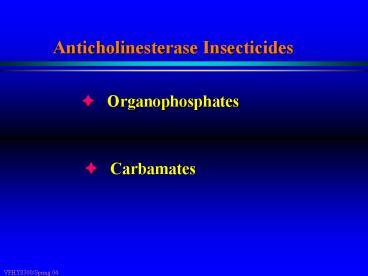Reported levels of fumonisins PowerPoint PPT Presentation
1 / 55
Title: Reported levels of fumonisins
1
Anticholinesterase Insecticides
? Organophosphates
? Carbamates
VPHY8300/Spring 04
2
Cholinesterase Inhibitors Organophosphates
and Carbamates
? Not persistent in the environment. ? Highly
toxic ? Commonly used on crops and animals ?
Rapidly absorbed and metabolized ? Short
biological half-life ? Inhibit enzyme
(cholinesterase) causing accumulation of
acetylcholine. Effects are essentially of
acetylcholine on synaptic junctions.
VPHY8300/Spring 04
3
Athens Diagnostic Laboratory (College of
Veterinary Medicine)
- Organophosphates Diazinon, Dursban, Phosmet,
Disyston, Parathion. - Carbamates Methomyl, Methocarb, Propoxur,
Temik - Chlorinated Hydrocarbons DDT, Endosulfan,
Lindane
VPHY8300/Spring 04
4
Review of basic physiology
? Electrical vs. chemical neurotransmission. ?
Synthesis, metabolism and actions of
acetylcholine. ? Muscarinic vs. nicotinic
effects. ? Acetylcholinesterase enzyme ?
Consequences of acetyl cholinesterase inhibition
VPHY8300/Spring 04
5
Anticholinesterase Agents
? Organophosphate Insecticides
? Initially developed as chemical warfare agents
? Original compounds like Tabun, Sarin, and
Soman, are extremely toxic Nerve Gas.
VPHY8300/Spring 04
6
VPHY8300/Spring 04
7
VPHY8300/Spring 04
8
Neurohumoral Transmission
Na
Cholinesterase
K
VPHY8300/Spring 04
9
Neurohumoral Transmission
Na
Cholinesterase
K
K
VPHY8300/Spring 04
10
Neurohumoral Transmission
Na
Cholinesterase
K
VPHY8300/Spring 04
11
Neurohumoral Transmission
Na
Cholinesterase
K
K
VPHY8300/Spring 04
12
Neurohumoral Transmission
Na
No Cholinesterase
K
K
VPHY8300/Spring 04
13
Neurohumoral Transmission
Na
No Cholinesterase
K
K
VPHY8300/Spring 04
14
VPHY8300/Spring 04
15
VPHY8300/Spring 04
16
VPHY8300/Spring 04
17
VPHY8300/Spring 04
18
VPHY8300/Spring 04
19
VPHY8300/Spring 04
20
VPHY8300/Spring 04
21
VPHY8300/Spring 04
22
The label contains most of the relevant
information
VPHY8300/Spring 04
23
Organophosphates
VPHY8300/Spring 04
24
Organophosphates
VPHY8300/Spring 04
25
Organophosphates
VPHY8300/Spring 04
26
VPHY8300/Spring 04
27
VPHY8300/Spring 04
28
Acetylcholinesterase inhibitors
The biological effects of acetylcholinesterase
inhibition are essentially the effects of
increased amount of acetylcholine
VPHY8300/Spring 04
29
VPHY8300/Spring 04
30
VPHY8300/Spring 04
31
VPHY8300/Spring 04
32
VPHY8300/Spring 04
33
Atropine
Atropa belladonna
VPHY8300/Spring 04
34
Central effects of acetylcholine
Acetylcholine is a universal neurotransmitter in
CNS and autonomic ganglia. Accumulation will
cause increased firing of neurons
General hyperactivity
However, only the chemicals that can penetrate
the blood brain barrier are toxic in the nervous
system.
VPHY8300/Spring 04
35
Muscarinic effects of acetylcholine
Lungs
Acetylcholine increases bronchial secretions and
constricts the sphincter muscles of air passages
Dyspnea, pneumonia
VPHY8300/Spring 04
36
Muscarinic effects of acetylcholine
Heart
Acetylcholine is a vagal neurotransmitter and
decreases the activity of heart muscles
Bradycardia, vagal arrest, blood flow
VPHY8300/Spring 04
37
Muscarinic effects of acetylcholine
GI tract
Acetylcholine increases glandular secretions and
constricts the smooth muscles of the GI tract but
relaxes sphincters
Vomiting, diarrhea, dehydration, salivation,
cramps
VPHY8300/Spring 04
38
Muscarinic effects of acetylcholine
Eye
Acetylcholine increases tears and constricts the
sphincter muscle of iris
Lacrimation and miosis
VPHY8300/Spring 04
39
Nicotinic effects of acetylcholine
Ganglia
Acetylcholine is a universal neurotransmitter in
all ganglia and therefore increases tone and
activity
Generalized hyperactivity, tremors
VPHY8300/Spring 04
40
Death usually involves paralysis of diaphragm.
VPHY8300/Spring 04
41
Organophosphate insecticides
- Non-reversible inhibitors of acetylcholinesterase
- Produce phosphorylated enzyme
- Dealkylation leads to aging
- Blood cholinesterase activity is a good
indicator of poisoning - Use of 2-PAM within a short time (2 hrs) is
useful - Use care while handling vomited material, skin
- Stomach contents or skin useful for chemical
analyses
VPHY8300/Spring 04
42
Symptoms of cholinesterase inhibition
- Vomiting, diarrhea, salivation, lacrimation
- Difficult breathing, congested trachea
- Miosis
- Bradycardia
- Muscle tremors, paralysis, respiratory failure
- Death by asphyxiation
VPHY8300/Spring 04
43
Treatment of cholinesterase inhibition
- Wash contaminated surfaces, pump stomach
- Tracheal tube, provide unobstructed respiration
- ATROPINE (for muscarinic effects)
- 2-PAM, only for organophosphates and shortly
after poisoning - Use care in cyanotic cats (no atropine)
- Intravenous feeding
VPHY8300/Spring 04
44
Organophosphate-induced delayed neuropathy (OPIDN)
? Ginger Paralysis Affected 20,000 people in
1930s. ? Tri-O-cresyl phosphate used to shine
ginger. ? Other reports 10,000 people in Morocco
by oil. ? Human, chicken, pig, cat susceptible. ?
Rodents and immature animals resistant. ? An
enzyme called Neurotoxic Esterase described ?
Only 4 of phosphorylable sites in most tissues.
VPHY8300/Spring 04
45
Organophosphate-induced delayed neuropathy
(OPIDN), continued
- Good correlation of NTE phosphorylation to
ability of chemicals to OPIDN has been obtained. - However, resistant species have similar NTE.
- Axonal degeneration may occur in insensitive
species. - NTE involves a two-step process inhibition and
aging, similar to cholinesterases. - No function of NTE is known.
- Esterase activity not essential for axonal health.
VPHY8300/Spring 04
46
Organophosphate-induced delayed neuropathy
(OPIDN), continued
- A dying-back phenomenon.
- Primary lesion is demyelination.
- Agents involved TOCP, DFP, Mipafox, EPN, etc.
- The condition is non-reversible.
- Some chemicals may cause reversible paralysis.
- TOCP is not a direct inhibitor, but metabolized
to active compounds.
VPHY8300/Spring 04
47
VPHY8300/Spring 04
48
(No Transcript)
49
(No Transcript)
50
VPHY8300/Spring 04
51
Carbamates
VPHY8300/Spring 04
52
VPHY8300/Spring 04
53
VPHY8300/Spring 04
54
VPHY8300/Spring 04
55
VPHY8300/Spring 04

